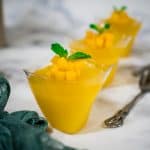Mango Jelly (Mango Agar Agar)
This homemade mango jelly cups are made using agar agar and fresh mango puree. They are quick, light and totally refreshing.
Servings: 1 liter of jelly
Calories: 959.9kcal
Ingredients
- 10 g agar agar powder
- 200 g white sugar
- 700 ml water
- 250 g mango puree (approximately 1 medium sized mango)
- 1 tablespoon lemon juice
- 2 tablespoon heavy cream
Instructions
- Prepare the molds before cooking the jelly. Wash and pat them dry and set aside.
- Peel the mango.
- Cut into cubes and process until fine. Add about 2 or 3 tablespoons of water if necessary. Measure the amount required for the recipe and set aside (see Note 1).
- In a separate bowl, mix the agar agar powder with sugar until well combined (see Note 2).
- Measure water into a medium sized pot and add the sugar-agar agar jelly mixture. Stir for about 30 seconds to disperse the jelly powder.
- Place the pot over low heat and cook until it comes to a rolling boil. Stir constantly to avoid jelly from clumping at the bottom of the pot.
- As soon as the jelly comes to a boil, add the mango puree and lemon juice. Stir well to combine.
- Turn off the heat as soon as the jelly starts to simmer.
- Transfer two thirds of the jelly into a separate measuring jug or pot. Add cream to it. Keep the remaining one third covered to avoid it from setting (see Note 3).
- Pour the cream mixed mango jelly solution into the prepared molds. Let them cool (see Note 4).
- Check the jelly in the refrigerator after about 5 to 10 minutes. Touch the surface to check if it has set. The jelly will still be wobbly at this stage and that is fine, suffice if the top surface is set.
- Remove the mango jelly cups from the fridge. Spoon the remaining jelly solution onto the first jelly layer very gently to avoid the layer from breaking.
- Return the jelly cups to the fridge to continue to set completely, approximately 2 to 3 hours (see Note 5).
- To serve, cut some fresh mango into small cubes and add to the jelly. Garnish with mint leaves.
- Keep leftovers refrigerated.
Notes
- You can also strain the puree to remove any mango chunks or pulp.
- Mix the powder in sugar helps prevent it from clumping when added to the water.
- Keep the unpoured jelly solution warm while waiting for first jelly layer to set to prevent it from setting in the pot. Keep it covered and heat up intermittently. Stir to prevent a layer of skin from forming on the top.
- Avoid placing the hot jelly into the fridge straightaway to prevent temperature change in your fridge. Placing the jelly under the fan for a few minutes will help to cool it down quicker.
- The deeper your molds, the longer it will take for the jelly to set. Test by shaking it gently. If it is still wobbly, the jelly is not set and should be allowed more time.
- You can use any type of mango to make this jelly, however, it is best made this variants that do not have too much thread or mango pulp.
- Undercooked jelly will not set properly. Make sure to cook the jelly solution until the agar agar powder is fully dissolved.
Nutrition
Calories: 959.9kcal | Carbohydrates: 224.2g | Protein: 3.2g | Fat: 11.4g | Saturated Fat: 6.5g | Polyunsaturated Fat: 0.6g | Monounsaturated Fat: 2.8g | Cholesterol: 30.8mg | Sodium: 52.7mg | Potassium: 527.7mg | Fiber: 4.4g | Sugar: 214g | Vitamin A: 2860.8IU | Vitamin C: 88.2mg | Calcium: 121.5mg | Iron: 2.4mg
